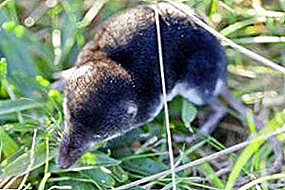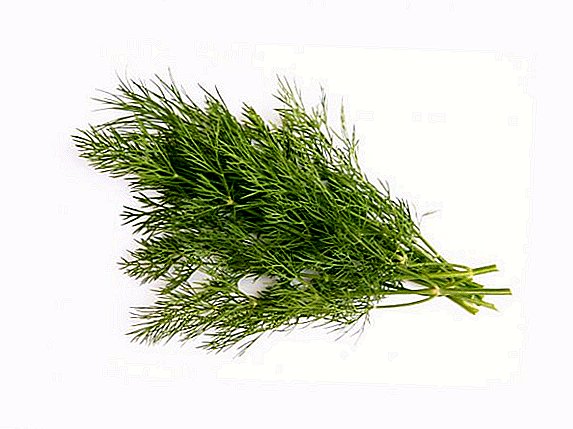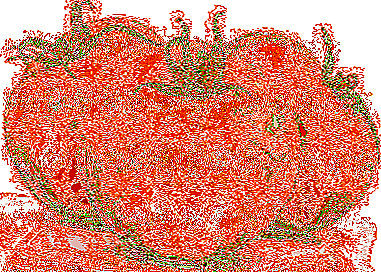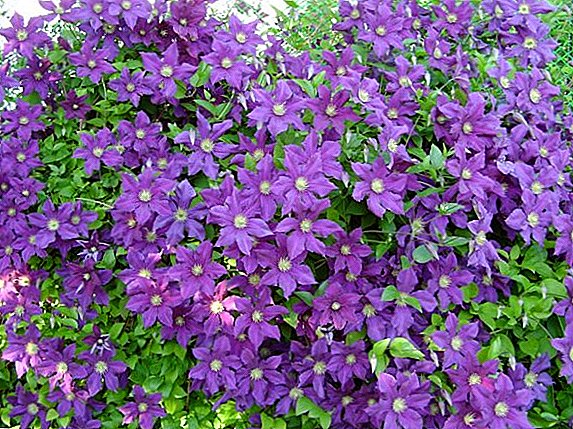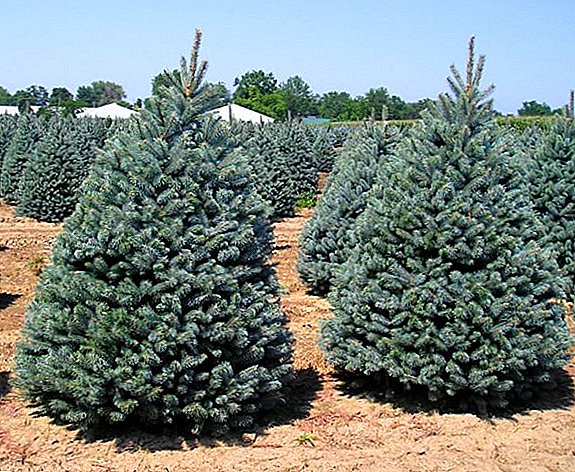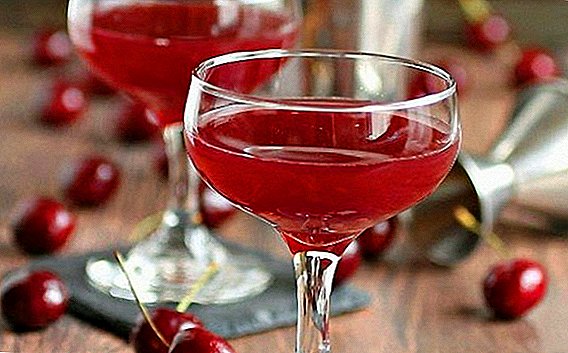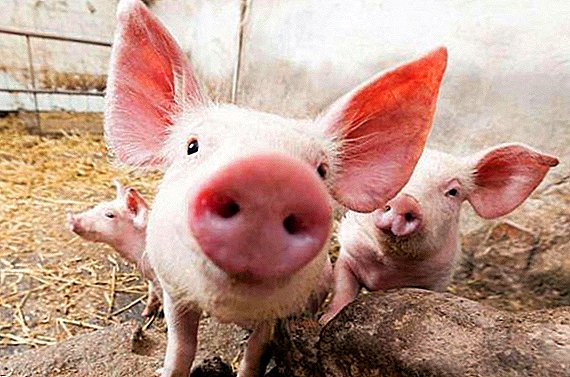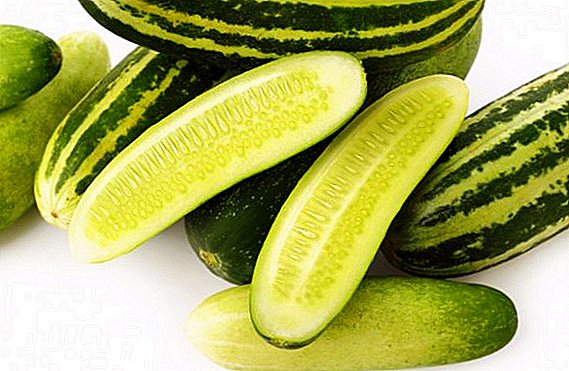 Cucumbers - the usual, traditional vegetables, which grows every gardener on his site. But thanks to scientists and breeders every day there are new and unusual varieties of cucumbers that can surprise even the most sophisticated gourmets. Most of these varieties can be grown independently. Despite the fact that they come from the tropics, while creating the necessary conditions for the growth of exotic plants, they adapt quite well in temperate latitudes. If ordinary cucumbers are no longer of interest, and agricultural experience requires a variety and new impressions, below are the names of some exotic cucumber varieties with a description of their characteristics that will not leave indifferent any summer resident.
Cucumbers - the usual, traditional vegetables, which grows every gardener on his site. But thanks to scientists and breeders every day there are new and unusual varieties of cucumbers that can surprise even the most sophisticated gourmets. Most of these varieties can be grown independently. Despite the fact that they come from the tropics, while creating the necessary conditions for the growth of exotic plants, they adapt quite well in temperate latitudes. If ordinary cucumbers are no longer of interest, and agricultural experience requires a variety and new impressions, below are the names of some exotic cucumber varieties with a description of their characteristics that will not leave indifferent any summer resident.
Chinese cucumbers
Chinese cucumber varieties got their name because their birthplace is China. Scourge of these cucumbers reach a length of 3.5 m, and fruits 40-90 cm, depending on the variety. Tastes of fruit are different in that they never taste bitter, have tender pulp, sweetish taste and subtle watermelon aroma. Chinese varieties have a high yield and bear fruit almost to the first frost. Among the shortcomings can be identified that such cucumbers are absolutely not subject to storage, therefore, the harvest should be harvested as consumption. In agrotechnology they are quite unpretentious, grow equally well in open ground and greenhouses.  The most important condition for their good taste - abundant fertilizer fertilizers containing nitrogen, potassium, calcium, boron. The lack of these elements is directly reflected in the appearance and taste of the fruit: they curl up and become tasteless. Propagation of Chinese varieties occurs by the seed method, and thick sowing should be carried out, since seed germination usually does not exceed 25%. Chinese cucumbers have many varieties, the most common of them: "Chinese long-fruited", "Chinese snakes", "Chinese miracle", "Boa", "Chinese white", which differ in the description of the appearance and taste characteristics.
The most important condition for their good taste - abundant fertilizer fertilizers containing nitrogen, potassium, calcium, boron. The lack of these elements is directly reflected in the appearance and taste of the fruit: they curl up and become tasteless. Propagation of Chinese varieties occurs by the seed method, and thick sowing should be carried out, since seed germination usually does not exceed 25%. Chinese cucumbers have many varieties, the most common of them: "Chinese long-fruited", "Chinese snakes", "Chinese miracle", "Boa", "Chinese white", which differ in the description of the appearance and taste characteristics.
Important! The harvest of Chinese cucumbers should be immediately used. When zalezhivanii fruits quickly lose moisture, shrink and become unsuitable in cooking.
Armenian cucumbers
Armenian cucumber is also known as tarra or serpentine melon. Gourd culture rather unknown to our gardeners has an unusual taste and has a very exotic look. The leaves of the plant are bright green, characteristic round shape. Fruits are light green, with a silvery "edge", segmented, cylindrical in shape. The sizes of cucumbers of this variety reach 45 - 50 cm. The main feature of the vegetable is the absence of an internal air cavity. Armenian cucumber is very juicy, crisp, white flesh with melon flavor.  Fruits contain up to 14% sugars, 15% solids and 7.5% starch, they are rich in vitamins and minerals, which is very useful for human metabolism. Such cucumbers can be eaten fresh along with the peel, or salted and canned. The plant is characterized by a long growing season and continuous fruiting, which persists until the first frost. Armenian cucumber also has a high resistance to cold and powdery mildew. The most common varieties of Armenian cucumbers are White Bogatyr, Silver Melon and Melon Fleuozus.
Fruits contain up to 14% sugars, 15% solids and 7.5% starch, they are rich in vitamins and minerals, which is very useful for human metabolism. Such cucumbers can be eaten fresh along with the peel, or salted and canned. The plant is characterized by a long growing season and continuous fruiting, which persists until the first frost. Armenian cucumber also has a high resistance to cold and powdery mildew. The most common varieties of Armenian cucumbers are White Bogatyr, Silver Melon and Melon Fleuozus.
Did you know? Armenian cucumber is famous for its healing properties. It is recommended to include in the diet of people suffering from obesity, diabetes, hypertensive crises, atherosclerosis, etc. The presence in the composition of cucumber folic acid contributes to the improvement of blood formation. Serpentine melon is widely used as a choleretic, laxative, diuretic.
Italian cucumbers
Unusual cucumber varieties of Italian breeders also differ by exotic characteristics and have their fans. First of all, these are varieties with beautiful names of cucumbers - "Abruzze" and "Barrese".
Variety "Abruzze" late, has a whip of medium length. Its cucumbers are unusual in that they have the usual taste of cucumber when young, and after ripening they acquire a melon taste and aroma. The leaves look like a melon, the fruits are ribbed, light green in color, about 35-45 cm long, with crispy, dense flesh and high taste. Young cucumbers are eaten as classic cucumbers, and mature ones are put in exotic and delicious dishes. Fruits "Abruzze" - a storehouse of vitamins and minerals, contain potassium, calcium, iron, phosphorus, iodine, carotene, vitamins of group B, PP, C and other elements.  Variety "Barrese" - this bush cucumbers, leaves and flowering of which also resemble a melon. The fruits are very similar to the "Abruzze" and almost no different. This is the same late-ripening variety with a long growing season that lasts at least 65 days. Ripe fruits "Barrese" - bright orange or intense yellow color, with dense crisp flesh and melon flavor. The advantages of this bush variety include the convenience of harvesting: cucumbers do not overripe and are clearly visible, plants are not very long, so they do not need to be tied up.
Variety "Barrese" - this bush cucumbers, leaves and flowering of which also resemble a melon. The fruits are very similar to the "Abruzze" and almost no different. This is the same late-ripening variety with a long growing season that lasts at least 65 days. Ripe fruits "Barrese" - bright orange or intense yellow color, with dense crisp flesh and melon flavor. The advantages of this bush variety include the convenience of harvesting: cucumbers do not overripe and are clearly visible, plants are not very long, so they do not need to be tied up.
These two varieties have one common disadvantage - they are bee-pollinated, that is, when grown in greenhouses, they require artificial pollination. They also do not have high yields, but, like all late maturing, they are very resistant to fungi and bacteriosis.
Lemon Cucumber
Externally, cucumber-lemon or, as they also call this variety, - "Crystal Apple" - really looks like citrus. Its mature fruit is of the same round shape and bright yellow inside and out. And here about flavoring qualities - here these cultures have no similarity. Fruits change their color during the entire period of maturation. Young cucumbers have a gentle peel with a small down, a light green color and a pleasant taste. By the time of full ripening, the fruits acquire a more saturated taste and bright yellow, lemon color.
In cooking, cucumber-lemon fruits are used in salads and preserved for the winter, and even when processed for preservation, cucumbers retain their shape and color. Cucumber-lemon contains a lot of vitamin C, which strengthens the immune system and gives energy. Lemon cucumbers are low in calories, so they are useful for people with obesity and metabolic disorders.  The plant has several advantages for which is highly valued by lovers of exotic animals in the country. First, it is its decorative. Cucumber-lemon looks great even in a pot on the windowsill and keeps fruiting until the first frost. Secondly, a good enough yield: up to 10 kg of fruit from one bush.
The plant has several advantages for which is highly valued by lovers of exotic animals in the country. First, it is its decorative. Cucumber-lemon looks great even in a pot on the windowsill and keeps fruiting until the first frost. Secondly, a good enough yield: up to 10 kg of fruit from one bush.
In this type of cucumber, only one drawback can be identified: the plant requires the installation of a support for growing. It is best to grow cucumber-lemon through seedlings, as the seeds are not very high germination. Cucumber-lemon is derived by Australian breeders, who also called it "crystal apple", thanks to the crystal clear moisture that is contained in its fruits. It has been scientifically proven that cucumber-lemons have choleretic and diuretic effects, stimulate appetite, help the stomach, liver, and kidneys work, and help in the treatment of kidney stones.
Melotria rough
Melotria rough - another unusual cucumber. Miniature fruits (1.5 - 2 cm) taste like a classic cucumber. The only difference is that the skin of the feline has not a continuous green, but a marble color and a slightly sour taste. This plant is great as a houseplant, and for growing in the summer cottage. Scourge tine branchy, reach three-meter length, the leaves look like cucumber, but smaller.  Melothria fructifies in the same way as other types of exotic cucumbers - before the first frosts. The leaves do not turn yellow, unlike ordinary cucumbers, and retain green color until the end of the growing season. Rough-growing melodrium is actively expanding, and the lateral shoots lying on the ground root perfectly. This variety of cucumbers is unpretentious in the care, requires standard agrotechnical procedures, as in the cultivation of conventional cucumbers. It is easiest to propagate a plant through seedlings; you can sow seeds into the ground, but in this case the fruits ripen later. One of the advantages of rough grains is resistance to diseases and pests.
Melothria fructifies in the same way as other types of exotic cucumbers - before the first frosts. The leaves do not turn yellow, unlike ordinary cucumbers, and retain green color until the end of the growing season. Rough-growing melodrium is actively expanding, and the lateral shoots lying on the ground root perfectly. This variety of cucumbers is unpretentious in the care, requires standard agrotechnical procedures, as in the cultivation of conventional cucumbers. It is easiest to propagate a plant through seedlings; you can sow seeds into the ground, but in this case the fruits ripen later. One of the advantages of rough grains is resistance to diseases and pests.
White Cucumber
The white cucumber is one of the varieties of Chinese cucumbers, this variety got its name due to its appearance. The fruit is white with a slight green tint and delicate sweetish taste, for which this variety is recognized as a delicacy. The plant has a long scourge, the fruits reach a length of 20 cm. The most common varieties of white cucumber are “White Angel”, “Snow White”, “Snow Leopard”, “Italian White”, “Bride”. The advantage of white cucumbers is their high cold resistance and shade tolerance, as well as resistance to diseases and pests. This culture is also drought resistant and tolerates a high temperature of +45 ° C. White cucumbers bear fruit before the first frost and give a good harvest, which can reach 800 kg from 1 hundred. It is most convenient to grow this long-crawling culture in the open ground using trellis, so cucumbers get more light, better ventilated. 
Indian cucumber - momordica
Momordica is an amazing plant of the pumpkin family. The name of the culture comes from the Latin momordicus - snappy. Momordica has several other popular names - Indian cucumber, Chinese bitter melon, cucumber-crocodile. Its fruit is a cross between cucumbers and pumpkin. The homeland of Indian cucumber is tropical and subtropical regions of Australia, Asia and Africa. The plant is an annual or perennial plants, which are distinguished by high decorative qualities at any stage of development, even when they do not bloom. This allows you to grow a plant near hedges and gazebos in the suburban areas.
For Indian cucumbers, long, fast-growing stems are characteristic, reaching two-meter long large light green carved leaves. The momordica flowers are bright yellow, their scent resembles the scent of jasmine. Fruits are large, reach 25 cm in length, elongated oval, covered with specific dense wart tubercles. Young fruits of light green color, become yellow-orange tones later: from a pale shade to bright carrot. The flesh of the fruit is a bright ruby color, very juicy, with seeds resembling watermelon.  In cooking, use only the immature fruits of Indian cucumber, which have a pleasant sour-bitter taste. To eliminate the bitterness of young fruits, they are soaked for several hours in salted water. In fully ripe fruit, the pulp is too bitter, it cannot be eaten. Momordica seeds are also edible, they are sweetish, taste like nuts, and can be eaten raw after the fruit ripens.
In cooking, use only the immature fruits of Indian cucumber, which have a pleasant sour-bitter taste. To eliminate the bitterness of young fruits, they are soaked for several hours in salted water. In fully ripe fruit, the pulp is too bitter, it cannot be eaten. Momordica seeds are also edible, they are sweetish, taste like nuts, and can be eaten raw after the fruit ripens.
Indian cucumber is very popular in Asian cuisine: salads, side dishes for meat dishes are prepared from its shoots and fruits, as well as added to soups and various stews. The leaves are also used as spices, they give the dishes a spicy bitterness or sour taste. The fruits of cucumber have beneficial properties, they contain amino acids, alkaloids, vitamins A, B, C, oils, saponins, phenols. Among the disadvantages of the culture, it is possible to single out the fact that the flowers of Momordica bloom in the late afternoon, when there are no pollinators, so you will have to pollinate manually.
Important! Working with momordika during the growing season should be very careful in long-sleeved clothing and gloves, since all parts of the plant are covered with glandular hairs that cause burns to the skin. As soon as the fruits ripen, the hairs die off and the plant becomes harmless.
Trichozant - serpentine cucumber
Trichozant is an annual plant. The plant is widespread in Australia and the countries of Southeast Asia. Trichozant is called serpentine cucumber because of its decorative, elongated and unusually curved shape, similar to a snake.
Ripened fruits reach lengths up to 1.5 m and weights up to 1 kg. The rind of a serpentine cucumber is thin, dark or light green, the flesh is tender and juicy. When the fruit ripens, the peel acquires an orange tint, and the flesh turns bright red. The feature of the serpentine cucumber is that if it grows without a support, it will simply stick to the greenhouse film wall. In order to increase the yield of trichosan, it is impossible to give its fruits to outgrow, they should be removed at the stage of technical ripeness. In this case, good fruiting will continue until frost. Popular for growing in suburban areas varieties of trichozant - “Serpentine", "Kukumerina", "Petor Ular", "Snake Guad".  Snake cucumber - one of the main components of Asian cuisine. Shoots, fruits and leaves are eaten fresh, as well as put in soups, stews, salads and other dishes. Also, cucumbers can be canned in the same ways as classic cucumbers. Trichozant attracts attention not only due to the appearance of cucumbers, but also due to the content of a large amount of vitamins, minerals and nutrients, especially iron. Therefore, serpentine cucumber is recommended to include in the diet of people suffering from diseases of the heart and blood vessels.
Snake cucumber - one of the main components of Asian cuisine. Shoots, fruits and leaves are eaten fresh, as well as put in soups, stews, salads and other dishes. Also, cucumbers can be canned in the same ways as classic cucumbers. Trichozant attracts attention not only due to the appearance of cucumbers, but also due to the content of a large amount of vitamins, minerals and nutrients, especially iron. Therefore, serpentine cucumber is recommended to include in the diet of people suffering from diseases of the heart and blood vessels.
Did you know? A decoction of trichozant helps eliminate fever and reduce heat, and the fruits have anti-inflammatory, antiseptic and astringent effects. Also, the healing properties of the plant has a root, which is crushed and sprinkled on eczema, and its infusion washed wounds. Serpentine cucumber is also useful for nursing mothers - it helps to increase the amount of breast milk, make it more nutritious and more beneficial.
Tladiant Doubtful - Red Cucumber
Tladiant dubious, or red cucumber - a unique exotic vegetable. The birthplace of this species is the country of the Far East. The red cucumber has the appearance of creepers and is often used to decorate personal plots. Its young fruits resemble ordinary cucumbers and reach 6 cm in length. As the fruit ripens, it becomes soft and red inside and out.  In cooking, immature fruits are used, which can be eaten raw or subjected to heat treatment. Red cucumbers are put in salads, various snacks, served as side dishes. Due to the high sugar content of the ripened red cucumbers they even prepare desserts, jams and preserves. Also, the vegetable is traditionally salted and canned. Tladiant has medicinal properties, a vegetable is an excellent prevention of diseases of the gastrointestinal tract. A decoction of the seeds is used as a choleretic and diuretic.
In cooking, immature fruits are used, which can be eaten raw or subjected to heat treatment. Red cucumbers are put in salads, various snacks, served as side dishes. Due to the high sugar content of the ripened red cucumbers they even prepare desserts, jams and preserves. Also, the vegetable is traditionally salted and canned. Tladiant has medicinal properties, a vegetable is an excellent prevention of diseases of the gastrointestinal tract. A decoction of the seeds is used as a choleretic and diuretic.
The advantages of tladiants are that it is a perennial culture, so there is no need to plant it every year. Among the shortcomings, it is possible to single out the fact that in conditions of middle latitudes, especially in the first year of cultivation, it is very difficult to achieve fruiting of red cucumber, the fruits do not have time to ripen. You will also have to self-pollinate the plant, because in conditions of natural growth insects that do not inhabit temperate latitudes pollinate the tladiant.
Important! Red cucumber is contraindicated for people with diabetes, because of the high sugar content in fruits.


